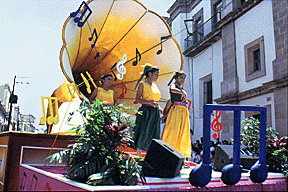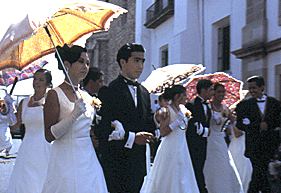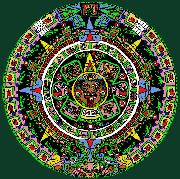|
As
you see yourself, I once saw myself; as you see me now, you will be
seen.
Mexican Proverb |

|
|
MEXICO
WORLD'S
MOST POPULOUS SPANISH COUNTRY
México
is the most populous Spanish-
speaking country in the world. According to the latest statistics, México's total population
is over 99 million. Mestizos, of Indian and Spanish blood),
make up 60%
of the population, followed by indigenous peoples
(30%), whites
(9%), and other ethnic minorities
(1%). |
|

|
|
Carnaval in Mazatlan
 Visitors
and locals scream, sing, shout and dance amid confetti and ribbons.
Bands of all kinds play the infectious rhythms of the State of Sinaloa.
And the food–oh, the food–camarones (shrimp) prepared in
every way possible, washed down with ice cold Pacifico beer, for it’s
Carnaval Time, Mazatlán’s biggest pachanga (fiesta). Visitors
and locals scream, sing, shout and dance amid confetti and ribbons.
Bands of all kinds play the infectious rhythms of the State of Sinaloa.
And the food–oh, the food–camarones (shrimp) prepared in
every way possible, washed down with ice cold Pacifico beer, for it’s
Carnaval Time, Mazatlán’s biggest pachanga (fiesta).
Read more
|
|
Updated
March
12, 2006
|
| |
SAN
MARCOS--THE FAIR OF FAIRS
by
Bob Brooke
 On a warm April morning as I strolled through the
San Marcos Gardens in Aquascalientes, a vendor beckoned me to come over
and have my fortune told by a supposedly clairvoyant canary. I had my
doubts, but he assured me that my future was in the cards. It seemed the
canary was to select a card from a deck of Tarot cards. As luck would
have it, the bird foretold happiness. This was the only luck I was to
have in the next few days, as I experienced the San Marcos National
Fair, the fair of fairs, which consumes the industrial city of
Aquascalientes, located at the very center of Mexico, from the second
week of April to the first week of May each year. It’s an occasion for
superlatives–the oldest, most famous and largest fair in all of
Mexico. On a warm April morning as I strolled through the
San Marcos Gardens in Aquascalientes, a vendor beckoned me to come over
and have my fortune told by a supposedly clairvoyant canary. I had my
doubts, but he assured me that my future was in the cards. It seemed the
canary was to select a card from a deck of Tarot cards. As luck would
have it, the bird foretold happiness. This was the only luck I was to
have in the next few days, as I experienced the San Marcos National
Fair, the fair of fairs, which consumes the industrial city of
Aquascalientes, located at the very center of Mexico, from the second
week of April to the first week of May each year. It’s an occasion for
superlatives–the oldest, most famous and largest fair in all of
Mexico.
Even though gambling is illegal in Mexico, I
had a chance to try my luck at a number of casino games, including a
roulette wheel and Blackjack, for the run of the fair. The fair
organizers submit a request to allow gambling for the length of the
Fair. The paperwork takes one and a half months to process. They submit
it at the beginning of the Fair and open up the casinos while the
paperwork is in progress. Then they retract the paperwork at the end of
the month before any decision has been made, thus allowing legal
gambling year after year. This could happen only in Mexico.
Visitors can also place their bets on fighting
cocks in the Casino which houses Latin America's biggest palenque,
or cock fighting arena. Cockfighting at the Fair, held in the first
palenque in Aquascalientes known as La Primavera, dates from 1874.
Around the middle of the 20th century its name was changed to Plaza de
Recreo. In the middle of the 1970́s, construction began on a new
5,000-seat arena on the site of the old one and named "Federico
Méndez," in honor of the late composer from Aguascalientes. It’s
without a doubt the largest and most modern cock-fighting arena in
Mexico and is part of the new Convention Center which, during the Fair,
also holds the Casino. During the rest of the year the Palenque is
converted into an auditorium for various events. I found the raucous
scene with men and women yelling their bets and the screeching of the
cocks a bit overwhelming. Alas, Lady Luck didn’t shine on me in any
part of the Casino.
The Traditions of the Fair
During the Fair, the whole city comes alive
with music that bursts from the heart and spills into the streets. This
fair of fairs has something for everybody–art expositions, music
concerts, plays, charreadas or Mexican rodeos, bullfights,
industrial-agricultural-livestock expositions, outdoor festivities and
pageants, lots of merrymaking, and a spectacular parade. As the sun
settles in the western sky, single men and women engage in the
time-honored tradition of watching or participating in the paseo
in which young women walk around the San Marcos Gardens in one
direction, young men in the other.
And tradition is what the San Marcos Fair is
all about. Dating back to 1604 when a small group of indigenous people
founded San Marcos, an Indian settlement on the outskirts of the Spanish
colonial city of Aguascalientes. The fair's religious origins have long
been forgotten. Today’s colorful three-week spectacular features
bullfights, folkloric dancing, mechanical games, cockfights, and
numerous cultural events, all vying for the attention of over a million
visitors from all over Mexico and North America. In fact, the fair forms
part of the identity of the people of Aquascalientes.
It’s only been since 1828 that the commercial
fair has been celebrated annually with processions lead by the civic and
religious authorities representing various neighborhoods.
By the year 1848, the fair moved from the plaza
of the government's palace located in the Parian or commercial center of
the city, to the San Marcos Gardens. Organizers also changed the date to
coincide with April 25, the date of the celebrations to honor St. Mark,
the Evangelist.
A Street Fair Extraordinaire
More than anything, this is a street fair, a
time when the residents of this otherwise bustling city come to the
streets to celebrate the arrival of Spring and have fun with their
families. At this time of year, hotels are packed, parties go on
forever, and the whole city buzzes with excitement. Local schools close
for part of the run of the Fair, and some local offices and factories
also close to celebrate. Topping the long list of festivities is the
crowning of the Queen of the Fair, a tradition that dates back 76 years.
The Fair is still held in the San Marcos
section of the city, the centerpiece of which is the impressive
18th-century Church of San Marcos, overlooking the San Marcos
Gardens, a lovely green shaded park laid out over 100 years ago. The
main part of the Fair takes place on a plaza surrounded by pink
neoclassical balustrades with ornamental ironwork and a beautiful
central fountain built out of pink stone.
In the Gardens, thick foliage and tall trees
shade paths and fountains, making it a place where locals, especially
young lovers, meet. During the Fair, the birdsong normally heard in the
park is replaced by shouting, laughing, and general merrymaking, as well
as spectacular firework displays and the cries of the many vendors
selling everything from delicious chicken enchiladas and the local
culinary specialty turkey in rich chocolate mole sauce, to candy floss,
giant balloons, ingenious handcrafted toys and cheap souvenirs. It
seemed everywhere I looked there was a vendor pushing a cart full of
sliced watermelon, cantaloupe and pineapple slices cut to look like
pinwheels. I found the aroma of fresh mangoes intoxicating.
The Parade
 On April 25th, "Dia de San
Marcos" or The Feast Day of St. Mark, a spectacular parade,
sponsored by the Aquascalientes Institute of Culture, winds its way
through downtown Aquascalientes. Besides the usual bands and marching
groups, the parade features giant floats, each showing off a particular
type of dance, from folkloric dances traditional to the State of
Aquascalientes, to more modern ones. The floats present what amounts to
a history of dancing and singing in Mexico, a cacophony of music to warm
the soul. On April 25th, "Dia de San
Marcos" or The Feast Day of St. Mark, a spectacular parade,
sponsored by the Aquascalientes Institute of Culture, winds its way
through downtown Aquascalientes. Besides the usual bands and marching
groups, the parade features giant floats, each showing off a particular
type of dance, from folkloric dances traditional to the State of
Aquascalientes, to more modern ones. The floats present what amounts to
a history of dancing and singing in Mexico, a cacophony of music to warm
the soul.
The object of the parade is to showcase the
colorful arts and traditions of Mexico through the efforts of teachers
and students of the arts, including singing classes for children and
adults, all types of musical classes, and danse classes from folkloric
to modern. All the music and choreography are the creations of the
teachers who volunteer their service to the Institute.
The parade begins by showcasing the mestizo
dances, which have resulted from the union of European rhythms,
especially Spanish, with those of Africa. Following these are the
authentic Mexican regional dances--sones, jarabes, cuadrillas, polkas,
redovas and schotis. Each float represents a different dance and has up
to four couples actually performing as it rolls along the parade route.
The crowds, sometimes as many as ten people deep, seem to cheer each
time a float rolls by. It’s a wonder anyone has any voice left after
the parade.
In addition to the artistic side of the San
Marcos Fair, bullfights are held in one of the largest and most
beautiful bullrings in Mexico.
There’s also an agricultural side to the
Fair. The Cattle Breeders Exposition held during the Fair is the oldest
of its class in Mexico. Competitions and exhibitions by cattle breeders,
dairy farmers, sheep ranchers, as well as livestock exhibitions of
cattle, goats, pigs and horses fill out the program, along with sheep
and goat searing demonstrations.
Lastly, a fair would be a fair without carnival
rides for the kids and the kid in most adults. |
|

